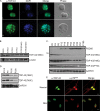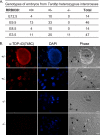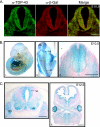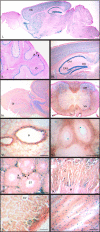TDP-43 is a developmentally regulated protein essential for early embryonic development
- PMID: 20040602
- PMCID: PMC2825476
- DOI: 10.1074/jbc.M109.061846
TDP-43 is a developmentally regulated protein essential for early embryonic development
Erratum in
- J Biol Chem. 2010 Dec 3;285(49):38740
Abstract
TDP-43 is a DNA/RNA-binding protein implicated in multiple steps of transcriptional and post-transcriptional regulation of gene expression. Alteration of this multifunctional protein is associated with a number of neurodegenerative diseases including amyotrophic lateral sclerosis and frontotemporal lobar degeneration with ubiquitin positive inclusions. Whereas a pathological link to neurodegenerative disorders has been established, the cellular and physiological functions of TDP-43 remain unknown. In this study, we show that TDP-43 is a nuclear protein with persistent high-level expression during embryonic development and with progressively decreased protein levels during postnatal development. In mice where the TDP-43 gene (Tardbp) was disrupted using a gene trap that carries a beta-galactosidase marker gene, heterozygous (Tardbp(+/-)) mice are fertile and healthy, but intercrosses of Tardbp(+/-) mice yielded no viable homozygotic null (Tardbp(-/-)) mice. Indeed, Tardbp(-/-) embryos die between 3.5 and 8.5 days of development. Tardbp(-/-) blastocysts grown in cell culture display abnormal expansion of their inner cell mass. The pattern of beta-galactosidase staining at E9.5 Tardbp(+/-) embryos is predominantly restricted to the neuroepithelium and remains prominent in neural progenitors at E10.5-12.5. TDP-43 is detected in spinal cord progenitors and in differentiated motor neurons as well as in the dorsal root ganglia at E12.5. Beta-galactosidase staining of tissues from adult Tardbp(+/-) mice shows widespread expression of TDP-43, including prominent levels in various regions of the central nervous system afflicted in neurodegenerative disorders. These results indicate that TDP-43 is developmentally regulated and indispensible for early embryonic development.
Figures







Similar articles
-
Loss of murine TDP-43 disrupts motor function and plays an essential role in embryogenesis.Acta Neuropathol. 2010 Apr;119(4):409-19. doi: 10.1007/s00401-010-0659-0. Epub 2010 Mar 3. Acta Neuropathol. 2010. PMID: 20198480 Free PMC article.
-
TDP-43, a neuro-pathosignature factor, is essential for early mouse embryogenesis.Genesis. 2010 Jan;48(1):56-62. doi: 10.1002/dvg.20584. Genesis. 2010. PMID: 20014337
-
Increased cytoplasmic TARDBP mRNA in affected spinal motor neurons in ALS caused by abnormal autoregulation of TDP-43.Nucleic Acids Res. 2016 Jul 8;44(12):5820-36. doi: 10.1093/nar/gkw499. Epub 2016 Jun 2. Nucleic Acids Res. 2016. PMID: 27257061 Free PMC article.
-
Pathogenic TARDBP mutations in amyotrophic lateral sclerosis and frontotemporal dementia: disease-associated pathways.Rev Neurosci. 2010;21(4):251-72. doi: 10.1515/revneuro.2010.21.4.251. Rev Neurosci. 2010. PMID: 21086759 Review.
-
Mutations in TDP-43 link glycine-rich domain functions to amyotrophic lateral sclerosis.Hum Mol Genet. 2009 Oct 15;18(R2):R156-62. doi: 10.1093/hmg/ddp303. Hum Mol Genet. 2009. PMID: 19808791 Free PMC article. Review.
Cited by
-
The role of TDP-43 mislocalization in amyotrophic lateral sclerosis.Mol Neurodegener. 2020 Aug 15;15(1):45. doi: 10.1186/s13024-020-00397-1. Mol Neurodegener. 2020. PMID: 32799899 Free PMC article. Review.
-
C9orf72-FTD/ALS pathogenesis: evidence from human neuropathological studies.Acta Neuropathol. 2019 Jan;137(1):1-26. doi: 10.1007/s00401-018-1921-0. Epub 2018 Oct 27. Acta Neuropathol. 2019. PMID: 30368547 Free PMC article. Review.
-
Sustained expression of TDP-43 and FUS in motor neurons in rodent's lifetime.Int J Biol Sci. 2010 Jul 4;6(4):396-406. doi: 10.7150/ijbs.6.396. Int J Biol Sci. 2010. PMID: 20616880 Free PMC article.
-
Uncovering Critical Roles for RNA in Neurodegeneration.Mo Med. 2023 Sep-Oct;120(5):374-380. Mo Med. 2023. PMID: 37841575 Free PMC article.
-
TDP-43, an ALS linked protein, regulates fat deposition and glucose homeostasis.PLoS One. 2013 Aug 13;8(8):e71793. doi: 10.1371/journal.pone.0071793. eCollection 2013. PLoS One. 2013. PMID: 23967244 Free PMC article.
References
-
- Wang H. Y., Wang I. F., Bose J., Shen C. K. (2004) Genomics 83, 130–139 - PubMed
-
- Ayala Y. M., Pantano S., D'Ambrogio A., Buratti E., Brindisi A., Marchetti C., Romano M., Baralle F. E. (2005) J. Mol. Biol. 348, 575–588 - PubMed
-
- Dreyfuss G., Matunis M. J., Piñol-Roma S., Burd C. G. (1993) Annu. Rev. Biochem. 62, 289–321 - PubMed
-
- Buratti E., Baralle F. E. (2008) Front. Biosci. 13, 867–878 - PubMed
Publication types
MeSH terms
Substances
Grants and funding
LinkOut - more resources
Full Text Sources
Other Literature Sources
Molecular Biology Databases

